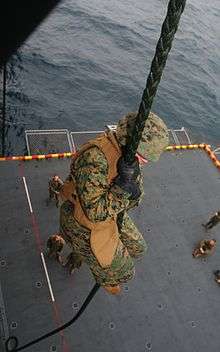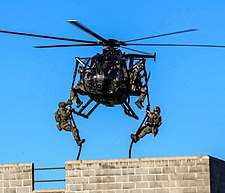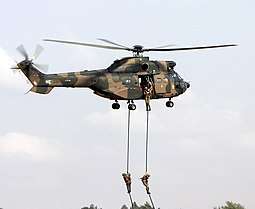Fast-roping
Fast-roping, also known as Fast Rope Insertion Extraction System (FRIES),[1] is a technique for descending a thick rope. It is useful for deploying troops from a helicopter in places where the helicopter itself cannot touch down.[2] Fast roping is particularly useful for marines, who can use the technique to board ships at sea as well as to reach destinations on land.[3] It is quicker than abseiling (rappelling), although more dangerous,[2] particularly if the person is carrying a heavy load, because the rope is not attached to them with a descender. The person holds onto the rope with gloved hands and feet and slides down it. Several people can slide down the same rope simultaneously, provided that there is a gap of approximately 3 metres (9.8 ft) between them, so that each one has time to get out of the way when they reach the ground.

History
First developed by the UK with British rope manufacturer Marlow Ropes, the first combat use of fast-roping was during the Falklands War. The original rope was a thick nylon that could be used in a manner akin to a firepole. The special ropes used today are braided (plaited), which results in a pattern on the outer circumference that is not smooth and so is easier to grip.[4] Originally, each person would hold the rope for the next person; however this has been phased out.
Equipment and techniques


Rope
The rope must be thick, typically 40 millimetres (1.6 in) diameter, to prevent it from being wildly jerked about from the rotor blast of the helicopter. Some types have a weighted core, the ballast helping to combat the blast effect.[5]
Glove techniques
Heat-resistant gloves are required for fast-roping, to protect the individual descending from friction-generated heat. Heat-resistant gloves are generally not dextrous enough to be useful after the descent has been completed, though specialized gloves have been developed for this purpose. More often, a glove-inside-glove technique is used, with tactical gloves worn inside heavy leather metalworking gloves. After descending the rope, the wearer removes the outer gloves to regain dexterity.[6]
Feet techniques
.jpg)
In the U.S. Marine Corps, fast-ropers are trained to control the speed of descent by using their legs and feet in addition to their hands (instructors claim that some Marines have let go of their rope because their gloves became too hot, causing injury). Deployment of around 25 fast-ropers onto a ship can take approximately 30 seconds.[2]
The British military advises against use of the feet as this can make the descent for following personnel more dangerous. Specifically, boot polish or the leather of the boot can make the rope extremely slippery.[7]
See also
References
- MCRP 3-01B.1 Helicopter Rope Suspension Techniques (HRST) Operations
- Bianco, Michael (21 June 2009). "31st MEU Marines Fast Rope and Hook N' Climb at Sea". Marines.mil. Archived from the original on 18 February 2013. Retrieved 11 July 2014.
- Harrer, Jacob (17 October 2013). "Fast roping prepares Marines for rapid ship-to-shore deployment". United States Marine Corps.
- "Fast Rope Inspection Manual" (PDF). Archived from the original (PDF) on 2014-03-07. Retrieved 2013-11-08.
- See, for example, US Patent No. 7954410
- Trew, Noel J. M.; Camping, John D.; Lee, Robert A.; Bean, Corey R. (2012). Putting Lives on the Line: The Fast Rope Glove Challenge (PDF) (Technical report). Air Force Research Laboratory. AFRL-RH-WP-TR-2012-0098.
- "The U.S. Navy's Combat Search and Rescue Units". Archived from the original on 2017-02-02. Retrieved 2017-01-29.
| Wikimedia Commons has media related to Fast roping. |